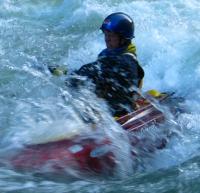Up: Equipment Reviews
Grateful Heads Helmest
Life jacket? Hypothermia protection? Helmet?
Many wilderness paddlers don't carry complete safety equipment - a
standard among white water sport paddlers nowadays. If rapids will be
encountered, a helmet is very useful. Also, you can save a lot of weight,
since a good helmet is much lighter than a spare head, and it
doesn't bleed when hit.
Of course, all your efforts should concentrate on avoiding a capsized
canoe with all your gear in. However, a capsize is not the major hazard.
More often a helmet "pays off" when tracking, lining, and getting in and
out of the canoe in white water sections.
Walking along the shores of rapids can be quite challenging.
Quite often, you will have to scout a rapid from shore, and, since slippery
boulders and loose rocks concentrate in these areas, it is just a matter
of time until you fall.

Especially in wilderness areas, it is a good idea, to leave your PFD
and helmet on during these activities! Look up some statistics about
canoeing accidents and you will regularly find some, where paddlers fell
when walking on rough shoreline-terrain alongside rapids, took a
blow on the head and slipped or rolled into the current of the river
where they drowned or suffered from hypothermia.
Helmets are easy available and affordable but often look kind of cheesy.
With some of them you look like after a failed psycho-forensic therapy.
With some, not with all of of them! Grateful Heads is a cool company making
even cooler helmets.
Reason enough for a review of some Grateful Heads helmets.
They come in 10 different basic designs. Together with a wide
variation of colours and colour effects you can configure your
individual helmet, which is functional and looks really cool.
As a multiple layer Kevlar lamination the construction is tough and
stiff, yet light. Outside you find the gel coat finish with other
effect materials, inside a fitting based on minicell foam. This has to
be customised first by sanding off some material here, glueing on one of
the included foam strips there, until the helmet fits you. The result is
an outfit with a better, softer shock absorbing quality than one based
on a system of belts, but one that cannot be easily adjusted to protect
another person's skull. Same with the chin straps, which are connected
to the helmet's body with stainless steel rivets: it takes some time to
adjust them, but once done it is fast and can offer a very precise fit.

What I especially like on wilderness trips is that no drainage-holes are
there to allow free entrance for bugs and rain. When playboating I
don't care because I am wet anyway, but on a trip I don't want my
hair to get wet if I could have the chance to stay dry, and I don't want
myriads of black flies hectically crawl through my hair and perforate my
skalp. There are enough attacking from the front but there I am able to
defend. My favorite model is the "Hawg", which is similar to the old steel
helmets of the german army and firefighters but with a narrower cut.
It's characteristic outbent rim with the step, separating the deeper part
in the back from the lower part in the face, combines a free view with
good protection of neck and ears without noise deadening effects. It
also keeps a threwn over mosquito netting at a distance to my skin and
rain from slowly running down my neck.
If you can't rise your head enough wearing helmets like this, because the
rim always touches the life jacket in your back, then you might want
a helmet with a rim that rises in the back, like the "drop zone"
or a model without any rim, like the "bird"
or the "work hat", the very best antiglare
model available.
Up: Equipment Reviews

